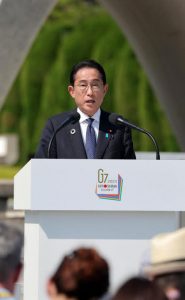Following conclusion of Hiroshima Summit, Part 2: Prime Minister Kishida
May 24, 2023
As prime minister’s unifying momentum has increased with “major accomplishments,” focus is now on timing of dissolution
by Koji Higuchi and Junya Kuchimoto, Staff Writers
On the morning of May 23, after a cabinet meeting held in the prime minister’s office, Japan Prime Minister Fumio Kishida returned to his official residence next door to spend time alone. The downtime for Mr. Kishida during the daytime on a weekday was unusual. Associates explained, “He had been working non-stop on the meeting,” giving the conclusion of his work as chair of the summit meeting of the G7 (Group of Seven industrialized nations) as the rationale for his rest.
Emphasizing his thoughts about hosting summit
“We accomplished a great deal,” declared Mr. Kishida confidently to the media on the evening of May 22, the day after the close of the G7 summit. He had invited to the A-bombed city of Hiroshima the leaders of three nuclear-weapon states the United States, the United Kingdom, and France, achieved a meeting between the G7 leaders and an A-bomb survivor at the Hiroshima Peace Memorial Museum in the city’s Naka Ward, and arranged for Volodymyr Zelenskyy, president of the embattled Ukraine, to make a surprise visit to Japan. According to several government officials, “The summit went surprisingly well.”
Mr. Kishida’s reputation was further burnished by his closing news conference, against the backdrop of the Cenotaph for the A-bomb Victims. Half of the opening statement to the media was devoted to his thoughts about the summit being held in Hiroshima.
“In the summer of 1945, Hiroshima was destroyed by the atomic bomb. This very place was also burned to the ground.” In his carefully crafted remarks, Mr. Kishida spoke of the A-bombing tragedy and called for “realization of a world without nuclear weapons by taking realistic steps one at a time.”
Just when it was announced that the news conference was over and Mr. Kishida was about to walk to the Cenotaph for the A-bomb Victims, a reporter in the front row posed an additional question about the path to nuclear disarmament. “Are you avoiding the issue?” Mr. Kishida turned around and went back to the podium. For roughly three-and-a-half minutes, he explained his own thoughts, sometimes adding emphasis by pounding on the podium, by looking ahead to the future. One diplomatic source said, “He had the appearance of a powerful leader. I think his determination got across to the public.”
The Cabinet's approval rating in opinion polls conducted by a variety of media organizations rose as a reflection of that view. A member of the Liberal Democratic Party (LDP) who is in the Kishida faction is already hinting that now might be the perfect time to dissolve Japan’s House of Representatives (the lower house of that country’s parliament). Yoichi Miyazawa, one of Mr. Kishida’s aides and the chairperson of the party’s Tax Research Commission, said “considering the prime minister’s personality, he would likely respond to the challenge” were opposition parties to submit a no-confidence motion against the Cabinet.
“I’m not considering dissolution”
Two years and five months remain before the terms of lower house members expire, and the election of president of the LDP will be held next year in the fall, more than one year off. If the Mr. Kishida seeks re-election as LDP president, “It would be too early to dissolve the Cabinet at this time,” according to one party executive. However, from now until the end of the year, discussions are unavoidable about increased burdens to be placed on Japan’s public, including the timing of a tax increase to strengthen national security and financial support to address the declining birthrate. As a result, there is a growing trend within the party to push for early dissolution while the prime minister’s momentum remains strong on the back of the successful Hiroshima Summit.
Mr. Kishida has been consistent when asked the question by the media three times before and after the G7 summit. “I am not considering dissolution,” repeatedly responded the prime minister. The ruling coalition junior partner Komeito Party is cautious about the idea of early dissolution of the House of Representatives. At a news conference on May 23, Natsuo Yamaguchi, chief representative of the party, warned, “Public support should not be the only reason for early dissolution. We must think about the issue calmly and objectively.”
Mr. Kishida’s decisions about the House of Representatives elections in October 2021, shortly after he was elected prime minister, and his Cabinet reshuffle in August 2022 mystified those around him. His decisions took both the ruling and opposition parties by surprise, given that he had never given the slightest hint that was what he would do. Will what happened twice in the past happen a third time? In Tokyo’s Nagata-cho, Japan's political center, the drive to learn what is on the prime minister’s mind about the issue intensifies.
(Originally published on May 24, 2023)








